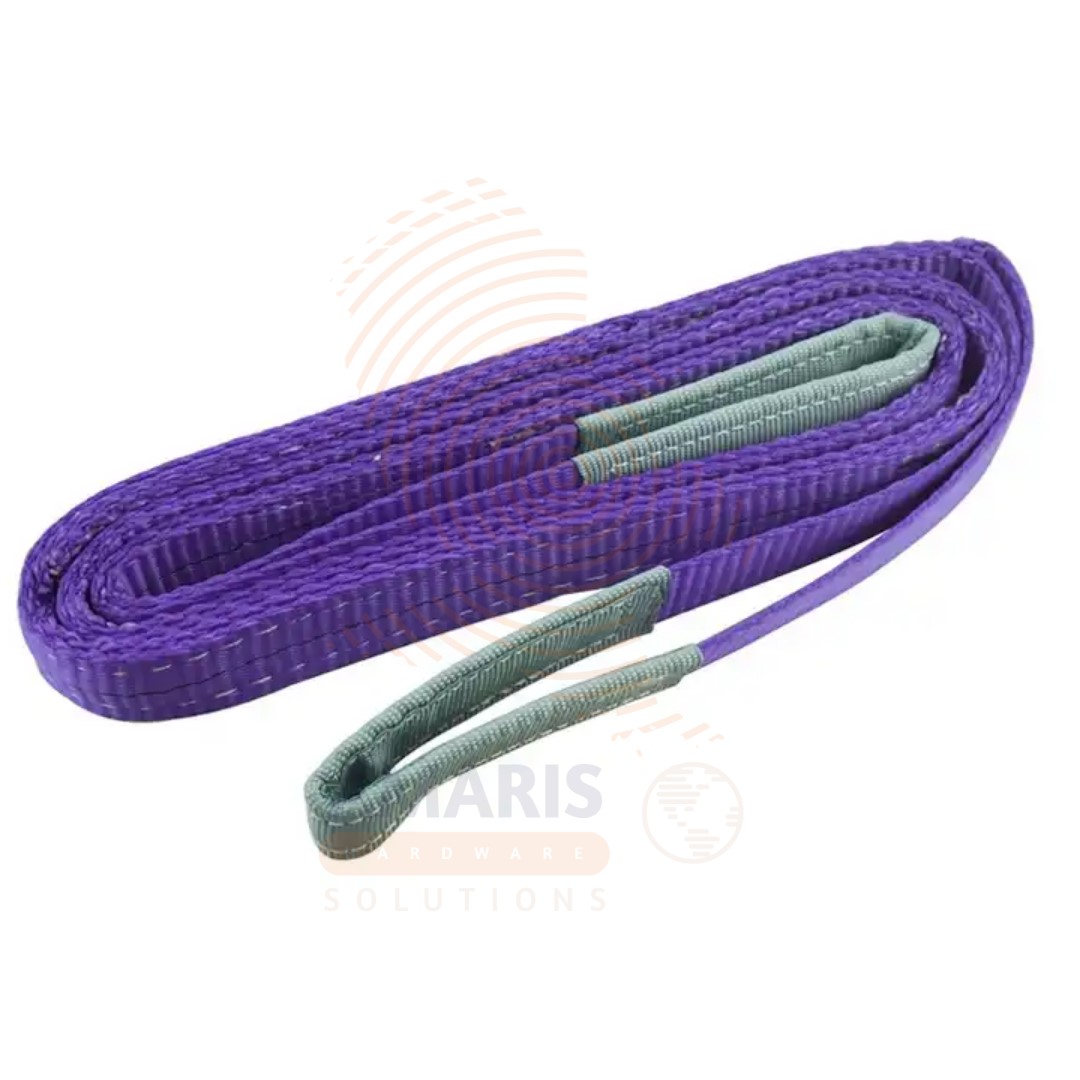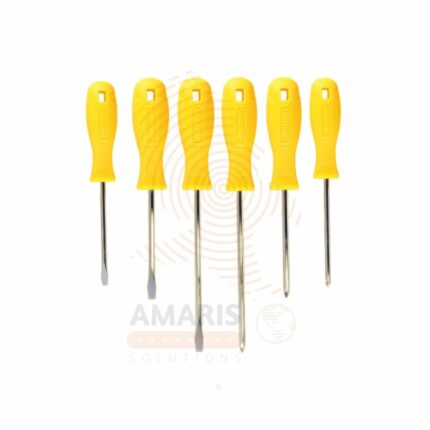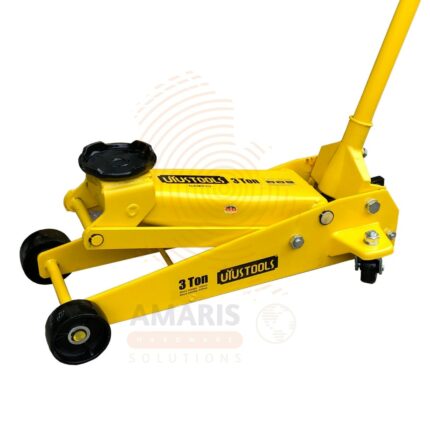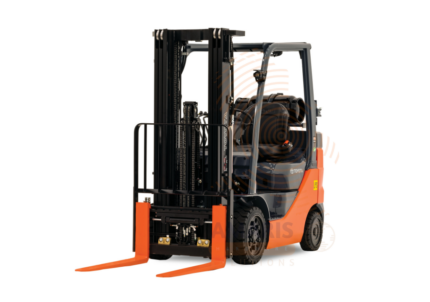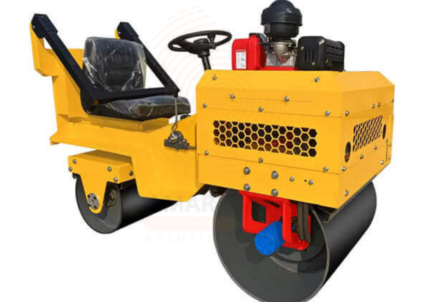Flat Webbing Slings
WhatsApp Order
A flat webbing sling is a flexible and durable lifting or towing device made from a flat strip of synthetic material, typically polyester, nylon, or polypropylene. These slings are designed for various material handling applications, such as lifting and securing loads in construction, manufacturing, and transportation industries. The flat design allows for a wide surface area, distributing the load evenly and reducing the risk of damage to the load. Flat webbing slings often feature reinforced loops at each end for attachment to lifting equipment, providing a versatile and reliable solution for lifting and moving heavy objects.
Description
Table of Contents
ToggleFlat Webbing Slings
Uses
-
Lifting and Hoisting: Flat webbing slings are frequently used for lifting and hoisting heavy loads in construction, manufacturing, and shipping. They provide a secure and even distribution of the load weight, reducing the risk of damage to both the load and the sling.
-
Load Securing: These slings are employed to secure loads during transportation. They can be used to tie down and stabilize cargo on trucks, trailers, or ships, ensuring that the load remains in place and is transported safely.
-
Material Handling: In warehouses and distribution centers, flat webbing slings are utilized for handling materials and goods. They can be attached to cranes, forklifts, or other lifting equipment to move and position items efficiently.
-
Construction and Rigging: Flat webbing slings are commonly employed in construction sites for tasks such as lifting steel beams, precast concrete elements, and other heavy construction materials. They are also used in rigging applications for setting up temporary structures.
-
Marine and Offshore Operations: Due to their resistance to moisture and corrosion, flat webbing slings are suitable for marine and offshore lifting applications. They can be used for lifting and securing loads on ships, docks, and oil platforms.
-
Utilities and Power Generation: Flat webbing slings are utilized in the maintenance and installation of equipment in power plants, utility facilities, and electrical infrastructure. They provide a reliable means of lifting and positioning heavy components.
-
Rescue Operations: In emergency situations, flat webbing slings can be employed for rescue operations, such as hoisting and lowering equipment or personnel in confined spaces or elevated locations.
-
Agricultural Applications: Flat webbing slings can be used in agriculture for lifting and moving heavy loads, such as bales of hay or machinery.
-
Event Rigging: In the entertainment industry, flat webbing slings may be used for rigging and suspending equipment, lighting, or scenery during events and performances.
-
Personal and Recreational Use: Smaller versions of flat webbing slings may be used in outdoor activities like camping, hiking, or rock climbing for various applications, such as securing gear or creating makeshift supports.
SAFETY HANDLING PRECAUTIONS
Safety Precautions
-
Inspection: Regularly inspect flat webbing slings before each use. Look for signs of wear, damage, cuts, or fraying. If any defects are found, replace the sling immediately.
-
Load Capacity: Always ensure that the flat webbing sling has the appropriate load capacity for the task at hand. Refer to the manufacturer's guidelines and markings on the sling to determine its maximum load capacity.
-
Proper Sling Selection: Choose the appropriate type and size of flat webbing sling for the specific lifting or rigging application. Different slings may have different properties and load-bearing capacities.
-
Correct Attachment Points: Attach the flat webbing sling to the load at designated and suitable attachment points. Avoid sharp edges and abrasive surfaces that may damage the sling.
-
Avoid Twisting and Knots: Prevent twisting or knotting of the flat webbing sling during use. Ensure that the sling lies flat against the load to maintain its strength and integrity.
-
Avoid Shock Loading: Avoid sudden or jerky movements, as these can lead to shock loading. Shock loading significantly increases the force on the sling and may cause failure. Lift and move loads smoothly and steadily.
-
Protect Against Abrasion: Use protective sleeves or pads to prevent abrasion and damage to the flat webbing sling, especially when lifting sharp-edged or abrasive loads.
-
Angle Adjustment: Take into account the angle of the sling when lifting. As the angle between the sling legs increases, the load on each leg also increases. Refer to load charts to determine the appropriate capacity for various angles.
-
Avoid Overloading: Never exceed the rated load capacity of the flat webbing sling. Be aware of the weight of the load and ensure it is within the safe working load limits of the sling.
-
Proper Storage: Store flat webbing slings in a clean, dry, and cool environment. Avoid exposure to direct sunlight, chemicals, and extreme temperatures, as these can degrade the material.
-
Training and Competence: Ensure that operators and riggers are properly trained in the safe use of flat webbing slings. Competent personnel should be responsible for inspecting, attaching, and using the slings.
-
Use in Conjunction with Proper Equipment: When using flat webbing slings with lifting equipment (e.g., cranes, hoists), make sure that the equipment is in good working condition and properly maintained.
-
Follow Manufacturer's Instructions: Adhere to the manufacturer's guidelines and instructions for the specific flat webbing sling being used. This includes information on inspections, usage, and maintenance.
-
Emergency Procedures: Have emergency procedures in place, including the knowledge of how to safely lower a load in case of equipment failure or emergency situations.
Related products
Boom Sprayer
A Boom Sprayer is an agricultural implement designed to apply liquids such as herbicides, pesticides, fertilizers, and water evenly over large crop areas. It features a horizontal boom equipped with multiple nozzles spaced at intervals, allowing for wide coverage and uniform spray distribution. Boom sprayers can be mounted on tractors, pulled behind as trailers, or be self-propelled units. They enhance the efficiency and accuracy of spraying operations in farming, reducing manual labor and ensuring effective crop protection and nutrition.
Direct Drive Air Compressor
A direct drive air compressor is a type of air compressor where the motor is directly connected to the compressor pump, typically without the use of belts or gears. In this configuration, the motor and the pump share a common shaft, resulting in a more compact and efficient design. Direct drive compressors are known for their simplicity, reduced maintenance requirements, and higher power transmission efficiency compared to belt-driven or gear-driven counterparts. They are commonly used in various applications, including powering pneumatic tools, inflating tires, and providing compressed air for industrial processes.
Fork lift
A Fork lift is a powered industrial truck used to lift, carry, and transport heavy materials over short distances, commonly used in warehouses, construction sites, manufacturing facilities, and loading docks. Equipped with two forks or prongs at the front, forklifts are designed to insert under pallets or heavy items and lift them using a hydraulic system. They come in various types, including counterbalance forklifts, reach trucks, pallet jacks, and rough terrain forklifts, each tailored to specific environments and tasks. Forklifts are essential for efficient material handling, reducing manual labor, improving safety, and streamlining operations in logistics and industrial settings.
Hydraulic Bottle Jack
PRODUCT DESCRIPTION
A hydraulic bottle jack is a mechanical device designed for lifting heavy loads by applying force through the use of hydraulic fluid. It typically consists of a vertical cylinder, within which a piston is situated. When force is applied to the piston, it displaces hydraulic fluid, creating pressure and causing the cylinder to lift, thereby raising the load. These jacks are commonly used in automotive and industrial applications for tasks such as lifting vehicles or supporting heavy machinery during maintenance or repairs. The compact design of a hydraulic bottle jack, resembling a bottle in shape, allows for ease of use in confined spaces.
Manual Forklift
A Manual Forklift is a non-motorized material handling device used to lift, transport, and position pallets and heavy loads over short distances. Operated by manual hydraulic pumping and steering, it is an efficient solution for warehouses, workshops, retail storage areas, and small-scale industrial operations. Unlike powered forklifts, manual forklifts require no electricity or fuel, making them cost-effective, low-maintenance, and ideal for indoor use. They typically feature adjustable forks, a hydraulic lift system, and sturdy wheels for maneuverability. Manual forklifts are commonly used where compact size, quiet operation, and precise handling are required in confined or controlled environments.
Road Roller
A Road Roller is a heavy-duty compaction machine used in construction to compress soil, asphalt, gravel, and other materials to improve surface stability and load-bearing capacity. It uses large cylindrical drums—sometimes vibratory or pneumatic—to eliminate air gaps and provide a smooth, dense surface. Road rollers are essential in road building, foundations, embankments, and landfills for long-lasting structural integrity.
Tractor
A tractor is a powerful motorized vehicle designed primarily for pulling or pushing agricultural machinery or trailers. It is a cornerstone of modern farming and land management, offering versatile performance in plowing, tilling, planting, harvesting, and hauling operations. Tractors are equipped with high-torque engines, large rear wheels or tracks, and a variety of attachment points, allowing them to operate over rough terrain and handle a wide range of tasks. They are also used in construction, landscaping, and material transport due to their durability and adaptability.
Vibrating Screen
A Vibrating Screen is an industrial screening machine used to separate materials by size through vibration. It consists of a mesh screen that oscillates to facilitate the sorting and classification of granular or particulate materials such as sand, gravel, minerals, coal, and aggregates. The vibration helps move materials across the screen while finer particles pass through the mesh openings, and larger materials continue over for further processing or disposal. Vibrating screens are vital in mining, construction, recycling, and material processing industries, enhancing efficiency by sorting materials quickly and accurately. They come in various configurations, including circular, linear, and elliptical motion screens, designed to meet specific application needs.


 Acrylic Sealants
Acrylic Sealants Construction Adhesives
Construction Adhesives Double-Sided Tape
Double-Sided Tape Duct Tape
Duct Tape Electrical Tape
Electrical Tape Epoxy & Resins
Epoxy & Resins Masking Tape
Masking Tape
 Automotive Wrenches & Socket Sets
Automotive Wrenches & Socket Sets Battery Chargers & Jump Starters
Battery Chargers & Jump Starters Car Jacks & Stands
Car Jacks & Stands Car Wash & Detailing Products
Car Wash & Detailing Products Diagnostic Tools
Diagnostic Tools Tire Inflators
Tire Inflators Vehicle Lighting
Vehicle Lighting Oil & Lubricants
Oil & Lubricants
 Adhesives & Sealants
Adhesives & Sealants Bricks & Blocks
Bricks & Blocks Cement & Concrete
Cement & Concrete Drywall & Plaster
Drywall & Plaster Flooring (Tiles, Wood, Laminate)
Flooring (Tiles, Wood, Laminate) Lumber & Plywood
Lumber & Plywood Paints, Primers & Coatings
Paints, Primers & Coatings Insulation Materials
Insulation Materials Roofing Materials
Roofing Materials
 Circuit Breakers
Circuit Breakers Electrical Cables & Wires
Electrical Cables & Wires Switches & Sockets
Switches & Sockets Fuses & Relays
Fuses & Relays Connectors & Terminals
Connectors & Terminals Electrical Boxes & Panels
Electrical Boxes & Panels Conduit & Fittings
Conduit & Fittings Lighting Fixtures & Bulbs
Lighting Fixtures & Bulbs Extension Cords & Power Strips
Extension Cords & Power Strips
 Anchors
Anchors Bolts
Bolts Clips & Clamps
Clips & Clamps Screws
Screws Nuts
Nuts Washers
Washers Rivets
Rivets Nails
Nails Threaded Rods
Threaded Rods
 Hammers
Hammers Measuring Tools (Tapes, Levels, Calipers)
Measuring Tools (Tapes, Levels, Calipers) Screwdrivers
Screwdrivers Pliers & Cutters
Pliers & Cutters Saws & Blades
Saws & Blades Chisels & Punches
Chisels & Punches Allen Keys & Hex Keys
Allen Keys & Hex Keys Ratchets & Socket Sets
Ratchets & Socket Sets Wrenches & Spanners
Wrenches & Spanners
 Power Tool Accessories (Blades, Bits, Discs)
Power Tool Accessories (Blades, Bits, Discs) Rotary Tools
Rotary Tools Saws (Circular, Jigsaw, Reciprocating)
Saws (Circular, Jigsaw, Reciprocating) Drills & Drivers
Drills & Drivers Grinders & Sanders
Grinders & Sanders Heat Guns
Heat Guns Nail Guns
Nail Guns Impact Wrenches
Impact Wrenches Batteries & Chargers
Batteries & Chargers
 Pipes & Fittings (PVC, Copper, PEX)
Pipes & Fittings (PVC, Copper, PEX) Plumbing Tools
Plumbing Tools Pumps & Motors
Pumps & Motors Sealants & Adhesives for Plumbing
Sealants & Adhesives for Plumbing Valves & Taps
Valves & Taps Water Heaters
Water Heaters Drainage Systems
Drainage Systems Faucets & Fixtures
Faucets & Fixtures Hoses & Tubing
Hoses & Tubing
 Hinges & Latches
Hinges & Latches Hooks & Brackets
Hooks & Brackets Window Hardware
Window Hardware Chains & Cables
Chains & Cables Casters & Wheels
Casters & Wheels Shelving & Storage Systems
Shelving & Storage Systems Door Handles & Locks
Door Handles & Locks Drawer Slides & Cabinet Hardware
Drawer Slides & Cabinet Hardware
 Personal Protective Equipment (PPE)
Personal Protective Equipment (PPE) Respirators & Masks
Respirators & Masks Safety Glasses
Safety Glasses Safes
Safes Security Cameras
Security Cameras Gloves
Gloves Helmets
Helmets Ear Protection
Ear Protection Fire Safety Equipment
Fire Safety Equipment Locks & Padlocks
Locks & Padlocks Motion Sensors & Alarms
Motion Sensors & Alarms
 Garden Fencing
Garden Fencing Garden Furniture Hardware
Garden Furniture Hardware Lawn Mowers
Lawn Mowers Trimmers & Edgers
Trimmers & Edgers Shovels & Spades
Shovels & Spades Rakes & Hoes
Rakes & Hoes Pruning Shears & Loppers
Pruning Shears & Loppers Watering Systems (Hoses, Sprinklers, Nozzles)
Watering Systems (Hoses, Sprinklers, Nozzles)
 Interior Paints
Interior Paints Paint Brushes & Rollers
Paint Brushes & Rollers Paint Strippers & Thinners
Paint Strippers & Thinners Paint Trays & Accessories
Paint Trays & Accessories Exterior Paints
Exterior Paints Spray Paints
Spray Paints Primers & Undercoats
Primers & Undercoats Varnishes & Stains
Varnishes & Stains
 Gaskets & Seals
Gaskets & Seals Hydraulic Fittings
Hydraulic Fittings Industrial Fasteners
Industrial Fasteners Industrial Hoses
Industrial Hoses Lubricants & Greases
Lubricants & Greases Metal Sheets & Bars
Metal Sheets & Bars Bearings & Bushings
Bearings & Bushings Belts & Pulleys
Belts & Pulleys
 HVAC Filters
HVAC Filters Insulation for HVAC
Insulation for HVAC Air Conditioners
Air Conditioners Refrigerants
Refrigerants Ventilation Ducts & Fittings
Ventilation Ducts & Fittings Thermostats & Controllers
Thermostats & Controllers Fans & Blowers
Fans & Blowers
 Pegboards & Hooks
Pegboards & Hooks Shelving Units
Shelving Units Storage Bins & Containers
Storage Bins & Containers Toolboxes & Tool Chests
Toolboxes & Tool Chests Workbenches
Workbenches Drawer Organizers
Drawer Organizers Labeling Supplies
Labeling Supplies
 Welding Accessories (Clamps, Brushes)
Welding Accessories (Clamps, Brushes) Welding Electrodes & Rods
Welding Electrodes & Rods Welding Helmets & Gloves
Welding Helmets & Gloves Welding Machines
Welding Machines Soldering Irons & Stations
Soldering Irons & Stations Flux & Solder Wire
Flux & Solder Wire
 Generator Accessories
Generator Accessories Inverters
Inverters Portable Generators
Portable Generators Power Inverters
Power Inverters Transfer Switches
Transfer Switches Diesel & Gasoline Generators
Diesel & Gasoline Generators
 Transport Equipment: Carts, Dollies, and Hand Trucks
Transport Equipment: Carts, Dollies, and Hand Trucks Storage Solutions: Pallets, Racks, and Containers
Storage Solutions: Pallets, Racks, and Containers Lifting Equipment: Hoists, Cranes, and Jacks
Lifting Equipment: Hoists, Cranes, and Jacks Conveyors and Accessories: Belts and Rollers
Conveyors and Accessories: Belts and Rollers